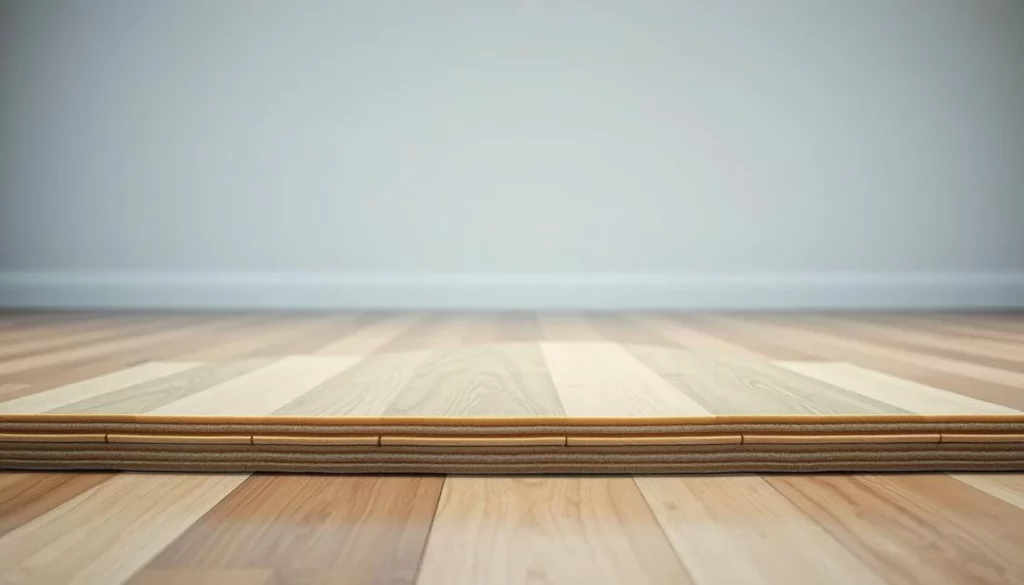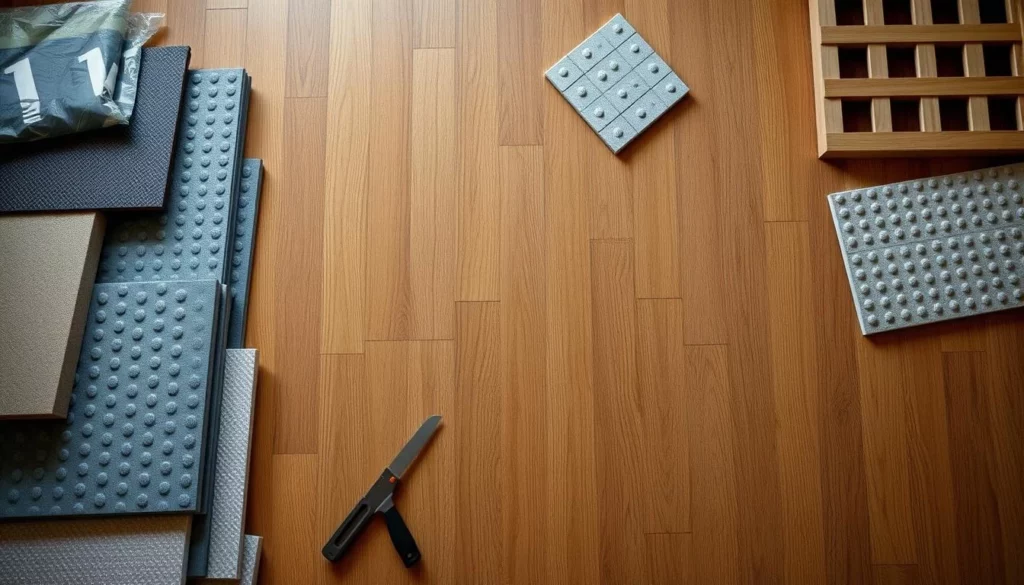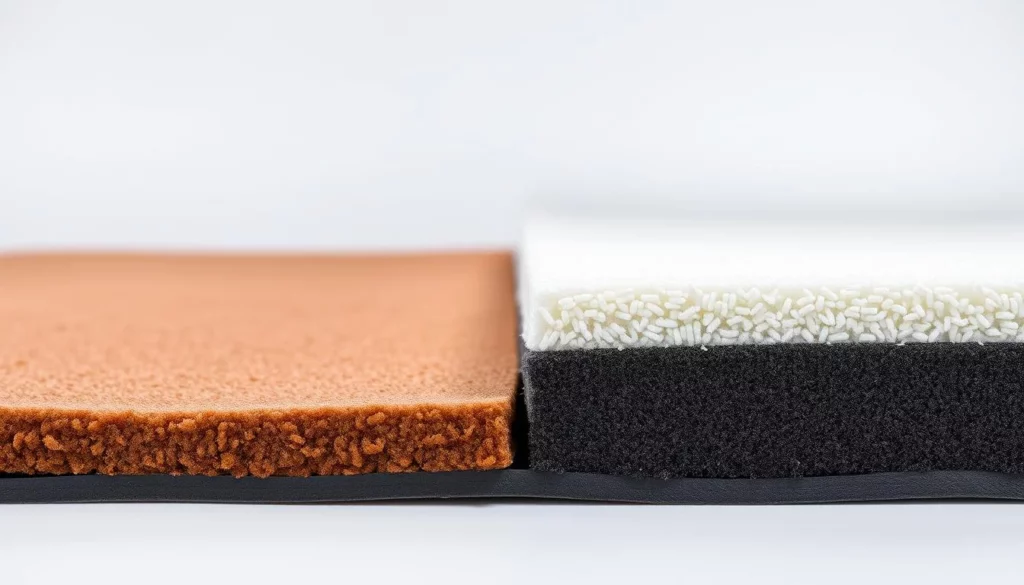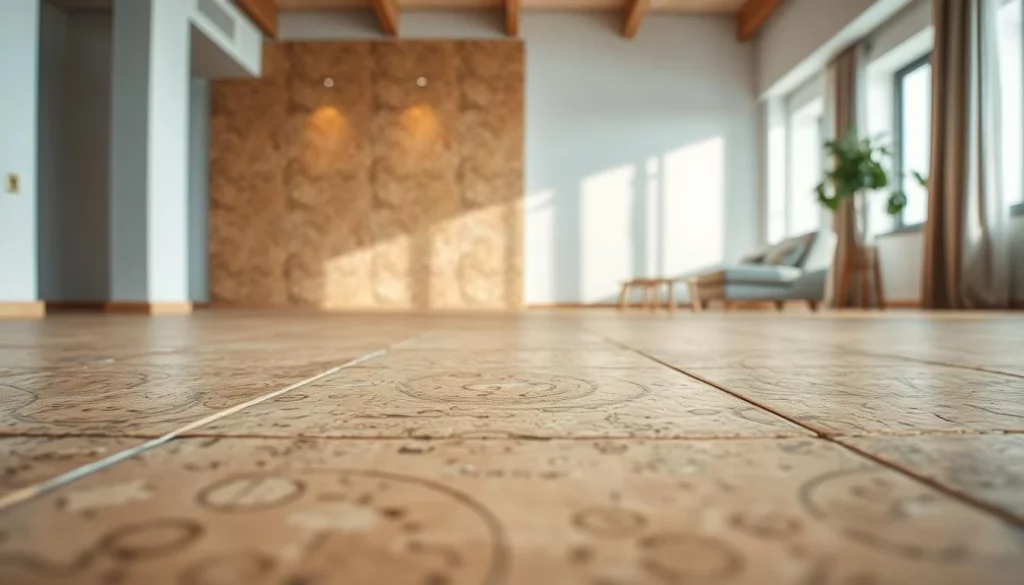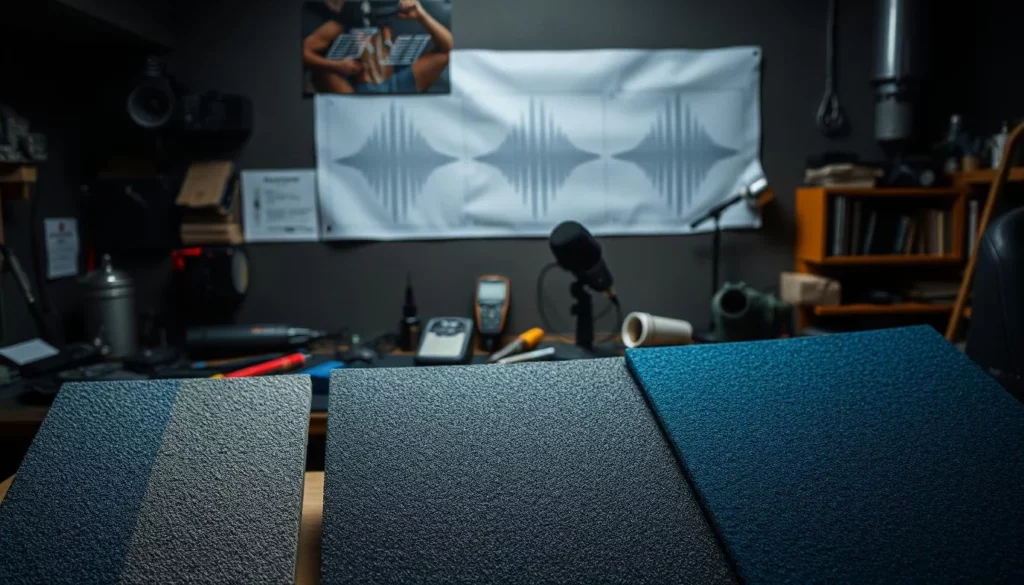Are you tired of hearing footsteps and movements in your home? Soundproof underlayment might be what you need. The Iso-Step Floor Underlayment is made to block impact sound well. It’s perfect for those who want a quieter home.
Installing the right underlayment for floor soundproofing can cut down impact noise a lot. The Iso-Step Floor Underlayment works with many floor types, making your home quieter. It’s easy to put in and works great, which is why many people choose it.
Want a more comfortable home? Start by cutting down on unwanted noise. With the Iso-Step Floor Underlayment, you can have a quieter, more peaceful space.
What is Floor Underlayment for Noise Reduction?
Looking to cut down on impact noise? Knowing about floor underlayment is key. It’s a layer between the subfloor and flooring that helps block noise.
Definition and Purpose
Floor underlayment for impact noise works as a sound barrier. It absorbs sound, making less noise travel through the floor. This is vital in homes with multiple floors or apartments, where noise from footsteps and drops can be a big issue.
Importance of Noise Reduction
Reducing noise is essential for a peaceful home. Too much noise can cause stress, disrupt sleep, and lower life quality. The best noise-reducing floor underlayment can greatly enhance your home’s sound comfort.
Common Materials Used
Different materials are used for sound dampening floor underlayment, like foam, cork, and rubber. Each has its own strengths. Foam is light and simple to put in, while cork naturally absorbs sound.
Knowing about these materials helps pick the right underlayment for your needs.
Benefits of Using Floor Underlayment
Using floor underlayment does more than just reduce noise. It makes your home more comfortable. The right underlayment can really improve your living space.
Enhanced Acoustic Performance
One key benefit of floor underlayment is its sound improvement. Acoustic floor underlayment materials soak up sound. This makes your home quieter, which is great for places with lots of noise.
- Reduces impact noise from footsteps
- Minimizes sound transmission between floors
- Creates a quieter living space
Increased Comfort
Floor underlayment also makes floors more comfortable to walk on. It adds a soft layer, which is perfect for hardwood or laminate flooring. These floors can feel hard and cold.
- Adds warmth and comfort underfoot
- Reduces fatigue from standing on hard floors
- Enhances overall flooring experience
Improved Thermal Insulation
Underlayment also helps keep your home warm. It stops heat from escaping through the floor. This makes your home more energy-efficient. Materials like foam or rubber are great at keeping warmth in.
- Reduces heat loss through the floor
- Improves energy efficiency
- Contributes to a warmer living environment
For instance, the WhisperMat-HW Hardwood Underlay does more than just reduce sound. It also protects your floor from moisture and works well with heated floors. This shows how good underlayment can solve many problems at once, making your flooring investment worth it.
Types of Floor Underlayment Materials
Choosing the right floor underlayment material is key for noise reduction. The right choice can greatly improve your flooring’s sound quality.
Foam Underlayment
Foam underlayment is a favorite for its affordability and easy setup. It comes in various thicknesses and densities, fitting different flooring types. High-density foam underlayment stands out for its ability to block noise and vibrations.
Cork Underlayment
Cork underlayment is a top pick for sound insulation. It’s made from natural cork and lasts long, resisting mold and mildew. Cork underlayment is also green and feels soft underfoot.
Rubber Underlayment
Rubber underlayment is great for blocking noise because it’s dense and flexible. It absorbs impact sounds and airborne noise. Recycled rubber underlayment is a green choice that still performs well.
Combination Underlayment
Combination underlayment mixes different materials for better results. For instance, foam and rubber together offer cost savings and top sound quality. These hybrid options aim to balance noise reduction and comfort.
Knowing about the various floor underlayment materials helps you pick the best for your needs. This ensures your flooring not only looks good but also sounds great.
How to Choose the Right Underlayment
Finding the right underlayment can really cut down on noise. But how do you pick the best one for your floors? It depends on your flooring type, how much noise you want to block, and your budget.
Consider the Flooring Type
Different floors need different underlayments. For hardwood or laminate, foam or cork works well. But tile or stone floors need something more durable and water-resistant.
- Foam Underlayment: Great for most floors, like laminate and hardwood.
- Cork Underlayment: Perfect for floating floors and blocks sound well.
- Rubber Underlayment: Durable, often used under tile or stone.
Assess Your Noise Reduction Needs
For blocking impact noise, like footsteps, choose an underlayment made for it. The Iso-Step Floor Underlayment comes in various thicknesses. It’s great for reducing impact noise.
| Underlayment Thickness | Noise Reduction Effectiveness | Suitable Flooring Types |
|---|---|---|
| 2 mm | Moderate | Laminate, Hardwood |
| 5 mm, 6 mm | High | Laminate, Hardwood, Tile |
| 10 mm, 12 mm | Very High | Tile, Stone, Hardwood |
Evaluate Your Budget
Underlayment prices vary by material, thickness, and brand. Knowing your budget helps. Remember, a pricier underlayment might cost more upfront but last longer and block more noise.
Think about your flooring, noise needs, and budget to choose the right underlayment. Whether you need sound dampening or impact noise reduction, there’s a perfect underlayment for you.
Installation Process of Floor Underlayment
To effectively minimize noise, you need to understand the proper installation of acoustic floor underlayment. The process involves several key steps that ensure your underlayment performs optimally.
Preparing the Subfloor
Before laying down the underlayment, it’s essential to prepare the subfloor. This involves:
- Cleaning the subfloor to remove any debris or old adhesive.
- Checking for any unevenness or cracks and filling them with a suitable compound.
- Ensuring the subfloor is dry and free of moisture.
Proper subfloor preparation is critical for the underlayment to lie flat and perform effectively.
Laying Down the Underlayment
Once the subfloor is ready, you can begin laying down the underlayment. Here are the steps to follow:
- Measure the room to determine how much underlayment material you’ll need.
- Cut the underlayment to size using a suitable tool, such as a utility knife or a saw.
- Lay the underlayment down, ensuring it covers the entire floor area without overlapping or leaving gaps.
Common Installation Mistakes to Avoid
When installing noise reduction underlayment for floors, there are several common mistakes to avoid:
- Not preparing the subfloor properly, leading to uneven underlayment.
- Overlapping or leaving gaps between underlayment sheets.
- Not securing the underlayment correctly, allowing it to shift over time.
By avoiding these mistakes, you can ensure your sound-blocking floor underlayment is installed correctly and functions as intended.
Top Products for Noise Reduction Underlayment
Homeowners looking to cut down on noise need the right floor underlayment. The market has many options, each with its own strengths. We’ll look at the best choices for noise reduction underlayment.
Overview of Leading Brands
Several top brands focus on making quality underlayment for less noise. Some of the most well-known are:
- Iso-Step Floor Underlayment
- WhisperMat-HW Hardwood Underlay
- QuietWalk Underlayment
These brands are known for their dedication to quality and soundproofing innovation.
Comparison of Features
When we compare top underlayment products, several things matter. These include:
| Product | Noise Reduction (dB) | Thickness (mm) |
|---|---|---|
| Iso-Step | 20-30 | 2-3 |
| WhisperMat-HW | 25-35 | 3-4 |
| QuietWalk | 15-25 | 2-3 |
This table shows how different products vary in noise reduction and thickness.
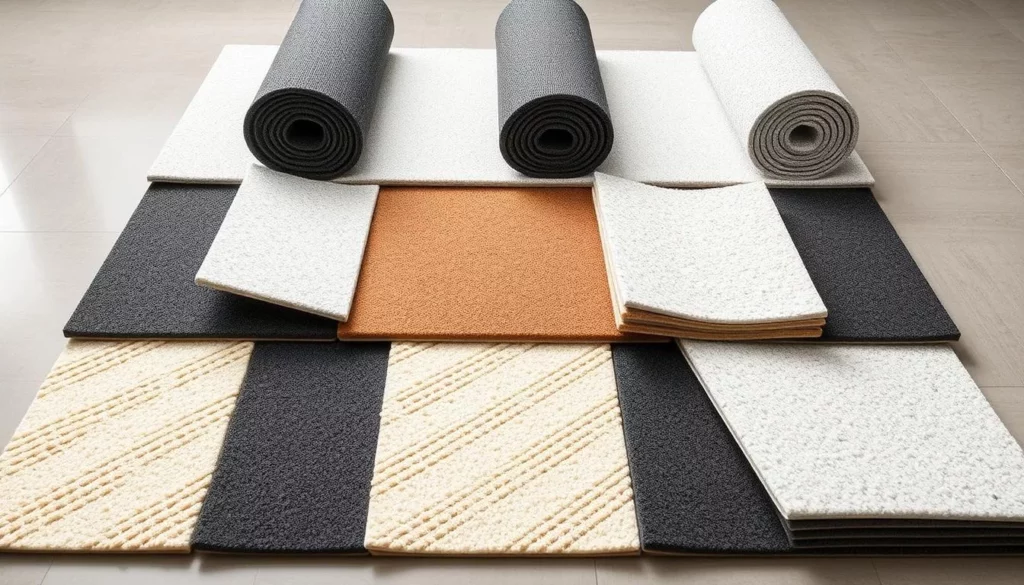
Customer Reviews and Ratings
What customers say is very important when choosing underlayment. Iso-Step and WhisperMat-HW are often praised for their ability to reduce noise and last long. QuietWalk is also liked for being easy to put in and offering good value.
Key benefits of these top products include better sound quality, more comfort, and better insulation against cold.
Maintenance Tips for Floor Underlayment
Proper care and maintenance of your floor underlayment can extend its lifespan. It ensures it keeps providing the best noise reduction. To do this, follow a few simple tips.
Regular Inspections
Regular inspections are key to spotting any issues with your floor underlayment. Look for signs of wear and tear, like tears, creases, or unevenness. It’s best to check your underlayment every six months.
- Check for any damage caused by moisture or water leaks.
- Inspect the underlayment for any signs of compression or flattening.
- Verify that the underlayment is properly aligned and not shifted.
Cleaning Recommendations
Cleaning your floor underlayment is easy. For most materials, a simple vacuum or sweep is enough to remove dirt and debris. For a deeper clean, use a damp mop but avoid too much water.
For Iso-Step Floor Underlayment, a top choice for homeowners, dry sweeping or vacuuming is recommended to keep it performing well.
Signs It Needs Replacement
Even with regular care, your floor underlayment might need to be replaced. Look out for these signs:
- Visible signs of wear and tear that cannot be repaired.
- A noticeable decrease in the underlayment’s performance, such as increased noise.
- Damage from water or moisture that has compromised the underlayment’s integrity.
Replacing your floor underlayment when needed ensures your flooring stays comfortable and quiet.
How Underlayment Affects Overall Home Value
The quality of your underlayment can make a big difference in your home’s appeal. When selling your home, every detail matters. The underlayment you choose can greatly affect your home’s value.
Impact on Home Resale
A top-notch underlayment like the WhisperMat-HW Hardwood Underlay can boost your home’s resale value. It not only reduces sound but also guards against moisture damage. This makes it a big plus for potential buyers.
Key Benefits for Resale:
- Enhanced acoustic performance
- Protection against moisture damage
- Increased overall durability of the flooring
Buyer Preferences
Today’s homebuyers want quiet and comfortable homes. An effective acoustic floor underlayment can make your home stand out. It’s a key selling point.
Buyers also value quality underlayment for its noise reduction and protection. Having a reputable noise reduction underlayment for floors is a big plus.
Investing in Quality Underlayment
Choosing a high-quality underlayment is wise. It’s not just for now but also for your home’s future value. Products like the WhisperMat-HW Hardwood Underlay offer long-term benefits like less noise and more durable floors.
| Underlayment Type | Noise Reduction | Moisture Protection |
|---|---|---|
| WhisperMat-HW Hardwood Underlay | High | Yes |
| Cork Underlayment | Medium | No |
| Rubber Underlayment | High | Yes |
By picking the right underlayment, you can make your home more appealing and possibly increase its value. Whether you’re selling soon or just want a better living space, quality underlayment is a smart choice.
Frequently Asked Questions about Underlayment
Choosing the right floor underlayment for noise reduction can be tricky. Many questions come up. Knowing the common concerns and myths helps you make a better choice.
Common Concerns
One big worry is the impact insulation class (IIC) rating. An IIC rating of 50 is usually seen as a good standard for sound-control underlayments. For the best soundproofing, look for an underlayment with a high IIC rating, like the Iso-Step Floor Underlayment. Learn more about IIC ratings and soundproofing on the Floor House BC website.
Myths vs. Facts
Many think any underlayment works for noise reduction. But, the type and quality of underlayment really matter. For example, cork underlayment is great for glue-down applications because it absorbs sound well.
Additional Resources
If you want to learn more about underlayment for soundproofing, check out trusted sources. Look into different soundproof underlayment options and their benefits. This will help you find the best one for your needs.
